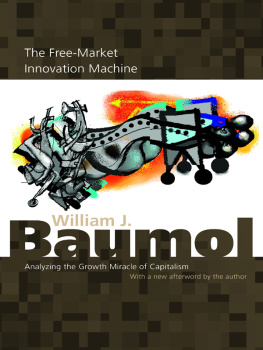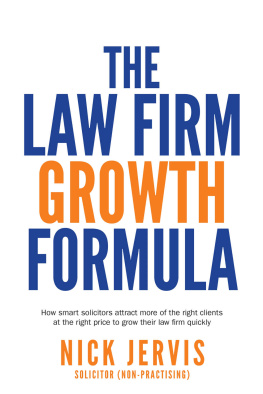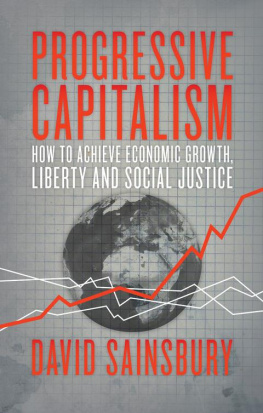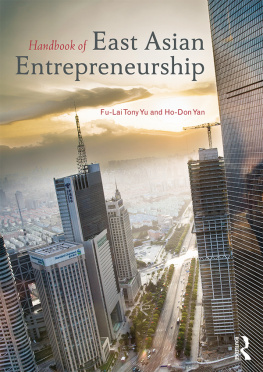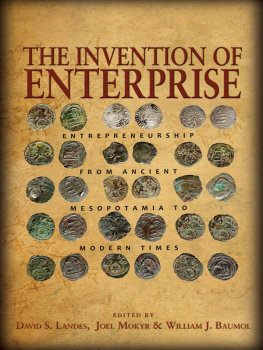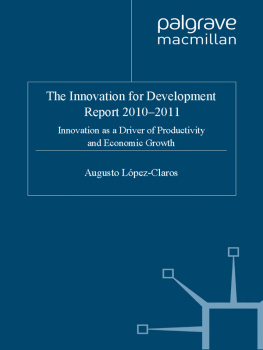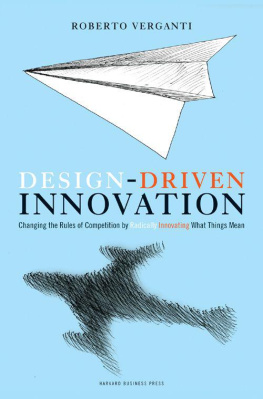
The Free-Market Innovation Machine
The Free-Market Innovation Machine
Analyzing the Growth Miracle of Capitalism
WILLIAM J. BAUMOL
PRINCETON UNIVERSITY PRESS
Princeton, New Jersey
Copyright 2002 by Princeton University Press
Published by Princeton University Press, 41 William Street, Princeton, New Jersey 08540
In the United Kingdom: Princeton University Press, 3 Market Place, Woodstock, Oxfordshire OX20 1SY
All Rights Reserved
Fourth printing, and first paperback printing, 2004
Paperback ISBN 0-691-11630-X
THE LIBRARY OF CONGRESS HAS CATALOGED THE CLOTH EDITION OF THIS BOOK AS FOLLOWS
Baumol, William J.
The free market innovation machine : analyzing the growth miracle of capitalism / William J. Baumol.
p. cm.
Includes bibliographical references (p. ) and index.
ISBN 0-691-09615-5
1. Capitalism. 2. Economic development. 3. Technological innovationsEconomic aspects. I. Title.
HB501 .B38 2002
British Library Cataloging-in-Publication Data is available
This book has been composed in Stone Serif by Princeton Editorial Associates, Inc., Scottsdale, Arizona
Printed on acid-free paper.
pup.princeton.edu
Printed in the United States of America
10 9 8 7 6 5 4
CONTENTS
PREFACE
If the past century of economic policymaking has taught us anything, it is that achieving strong long-term growth often has less to do with macroeconomic policies than with good microeconomics, including fostering competitive markets that reward innovation and restricting government to only a limited role.
The Economist magazine,
7 October 2000, p. 21
The unifying framework is the characteristic of knowledge as a semipublic good, with non easily enforceable property rights. Its diffusion, in principle, is good for social well being, but bad for private returns: No one wants to invest in the creation of new knowledge, if the rents generated are not, at least partly, appropriable. Institutions that govern the creation and the diffusion of knowledge have invariably been molded by this tradeoff.
Navaretti, Dasgupta, Mler,
and Siniscalco, 1998, p. 1
Much like the professor who never changed the questions on his examinationsonly the answerssome of the content of this book is a repetition of material in an earlier volume,for such swings is to be found in the way in which the market mechanismtogether with institutional arrangementsinfluences, not the creation, but the allocation of entrepreneurship between productive and unproductive (rent-seeking) pursuits. It was my contention that entrepreneurs as a group do not just appear or disappear in some primordial ooze. Rather, they can be and are reallocated by economic conditions and circumstances into (or out of) activities that appear not to be entrepreneurial because of the preconception that enterprising activity is necessarily productive. But entrepreneurs, like many others, are motivated primarily by prospects of wealth, power, and prestige, and, like people in any other occupation, entrepreneurs range widely in the degree to which morality and concern over the public welfare constrain their activities. Consequently, when institutional arrangements happen to offer greater rewards to enterprising rent-seeking or to destructive activities such as warfare or organized crime than they offer to productive entrepreneurial activity, we can expect an economys entrepreneurial effort to be allocated away from the more productive undertakings. In the earlier book, I concluded that the most promising way for a society to stimulate productive entrepreneurial activity is to reduce the rewards to unproductive or destructive rent-seeking. I also went beyond this generalization and provided some concrete illustrations of such policy measures.
The orientation of this book is very different. Here, my purpose is to begin to analyze what may well be the most critical attribute of the free-market economy (the type of economy in which we live): its ability to produce a stream of applied innovations and a rate of growth in living standards far beyond anything that any other type of economy has ever been able to achieve for any protracted period. My central contention here is that what differentiates the prototype capitalist economy most sharply from all other economic systems is free-market pressures that force firms into a continuing process of innovation, because it becomes a matter of life and death for many of them. The static efficiency properties that are stressed by standard welfare economics are emphatically not the most important qualities of capitalist economies. Rather, what is clear to historians and laypersons alike is that capitalism is unique in the extraordinary growth record it has been able to achieve; in its recurring industrial revolutions that have produced an outpouring of material wealth unlike anything previously seen in human history.
Moreover, it seems indisputable that innovation accounts for much of this enviable growth record. But what attributes of capitalism are responsible for this dramatic superiority in its record of innovation? The answer I propose here is that in key parts of the economy the prime weapon of competition is not price but innovation. As a result, firms cannot afford to leave innovation to chance. Rather, managements are forced by market pressures to support innovative activity systematically and substantially, and success of the efforts of any one business firm forces its rivals to step up their own efforts. The result is a ferocious arms race among the firms in the most rapidly evolving sectors of the economy, with innovation as the prime weapon. At the same time, there is profit to be earned by an innovating firm by licensing others, at a suitable price, to use its proprietary technology. The result is widespread cooperation among firms in the dissemination of up-to-date technology, and that, in turn, hastens widespread replacement of obsolete products and processes. These developments, I suggest, are a crucial part of the explanation of capitalisms growth accomplishments.
This does not mean that entrepreneurs have been deprived of any important role. On the contrary, they continue to contribute critical technical breakthroughs and other vital forms of stimulus to growth. The point, rather, is that their role has become only part of the story. Alongside their own activity, which itself is not unprecedented historically, a new, systematized, bureaucratized, and highly efficient set of parallel activities is being carried out within the innovative oligopolistic corporations, as a means to make the process of technical change as riskless as possible. And it is this that transforms innovation and growth from a process beset by fortuitous elements into a powerful mechanisma machine whose products are innovation and growth.
A striking example will suggest how this has changed the processes of discovery and innovation. In the early days of petroleum exploration, those who carried it out were quite suggestively described as wildcatters. Many of them relied on little more than intuition, superstition, and recourse to magic in selecting the sites where their drilling would take place. I understand that, nowadays, this process continues to be referred to as wildcatting, but the decisions on drilling location are often made in faraway laboratories and offices. Which of the locations under consideration offers the most promising prospects is determined with the aid of computers systematically conducting complex analyses of the known geological attributes of those locations. It is this sort of systematized approach to discovery and invention that lies at the heart of the innovation assembly-line of the free-enterprise economy. The goal of this book is to investigate the economic forces that have not only led to this sort of change, but that also impose and can be expected to continue to impose such change upon the economy.
Next page
